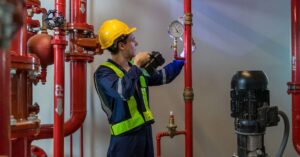Any ambitious business owner will tell you that growing a business is exciting. You’re getting new assets, adding inventory, renting bigger spaces, and often rolling out new technologies that are hard to understand at first. While market share and revenue usually get most of the attention, strong risk management (especially fire safety) is an underrated part of long-term growth. If you ignore it, you could lose years of work in just a few minutes.
As your building footprint increases and more people work on site, your legal responsibilities under the fire code grow as well. From a practical standpoint, having working, easy-to-reach firefighting equipment is one of the simplest ways to protect operations. That’s why a clear schedule for inspections and maintenance is so important.
Regular checks and prompt professional servicing ensure your portable extinguishers are charged, properly pressurized, and ready to use if something goes wrong. Having a trusted partner to refill fire extinguisher units on a regular schedule becomes a must-have part of your tactical plan, not an optional extra. It’s the foundation of reliable, uninterrupted scaling.
Protecting Your Digital Infrastructure
For almost any growing business today, expansion also means leaning harder on digital infrastructure. As your company grows, so does the power and complexity of your IT setup. You add more equipment, need more floor space, and rely more heavily on servers and connectivity to keep revenue coming in.
That puts a spotlight on your data center or server room—your operational nervous system. Standard building sprinklers aren’t enough here. In fact, a traditional water-based system that might work for general office fires can instantly destroy sensitive, irreplaceable electronic equipment, turning a small incident into a major outage.
The Case for Clean Agent Suppression to Protect Data
When it comes to server room fire suppression, clean agents like FM-200, Novec 1230, or inert gas mixtures play a critical role. These systems work by chemically or physically interrupting the fire triangle (heat, fuel, oxygen) without leaving residue.
Discharge speed is crucial: they’re designed to knock down a fire in its early stages—often within seconds—before temperatures climb high enough to damage hardware and before smoke penetrates circuit boards. A fast, clean discharge helps protect hard drives, network cables, and power supplies while minimizing downtime, so your systems can often be reset and brought back online in hours instead of days or weeks.
Combining Safety with Growth
When you’re scaling a business, your safety strategy has to grow alongside your infrastructure. Every time you add new server racks, reconfigure your floor space, or move into a larger building, your fire protection plan should be reviewed and updated. A qualified fire safety partner can help recalculate and redesign your server room suppression system to match the new room volume, equipment layout, and risk profile.
Part of that process often includes room integrity testing. This checks whether the protected space can hold the clean agent at the right concentration for long enough to fully suppress a fire. Even seemingly small changes—like adding cable openings, cutting new penetrations in the wall, or changing the ceiling—can affect how well your suppression system works. That’s why periodic re-testing is essential whenever the room structure or layout is altered.
Beyond data centers, a centralized approach to fire protection makes it easier to keep your entire facility compliant. The same partner who designs and maintains your suppression system can often coordinate inspections, maintenance schedules, and documentation for your extinguishers, alarms, and other fire safety equipment. This kind of unified oversight simplifies compliance across locations and reduces the chance that something gets missed in the rush of day-to-day operations.
Conclusion
As companies grow, there’s a natural temptation to focus on what’s visible: new customers, new offices, new technology. But long-term success depends just as much on protecting what you’ve already built. Treating fire protection as a strategic investment in continuity (not just a cost line) helps you safeguard your assets, your data, and your people.
In practice, that means three things:
- Making sure core firefighting tools like extinguishers are always maintained, accessible, and ready to use.
- Protecting critical infrastructure, such as server rooms, with the right type of suppression system—not relying on generic solutions that can cause more harm than good.
- Regularly revisiting your fire safety setup whenever you scale, renovate, or reconfigure your spaces.
When you bake these steps into your growth plans, you’re not just checking a compliance box. You’re giving your business a better chance to survive the unexpected and keep serving customers, even when something goes wrong. That’s the difference between a company that grows quickly and one that grows sustainably.
FAQ
Yes, many commercial-grade fire extinguishers are designed to be recharged multiple times, especially units with metal valves such as ABC dry chemical, CO₂, clean agent, or Class K models. However, refilling should be done by certified professionals with the right equipment. It’s not a DIY job, since incorrect pressure or agent can make the extinguisher unsafe or ineffective.
Costs vary based on the size and type of extinguisher, as well as your local market rates. But a typical range for refilling small portable units is around $15–$50 per extinguisher, with specialized or larger units costing more. For budgeting, it’s best to get a quote from a local, licensed fire protection company.
Fire extinguisher refills are typically handled by licensed fire protection or life safety companies that offer inspection, maintenance, and recharge services. In many areas, these providers can come on-site to service multiple units at once, ensuring your extinguishers are refilled, properly tagged, and compliant with local fire codes.

This content is from a contributor and may not represent the views of Tech Help Canada. All articles are reviewed by our editorial team for clarity and accuracy.
Want a heads-up once a week whenever a new article drops?







